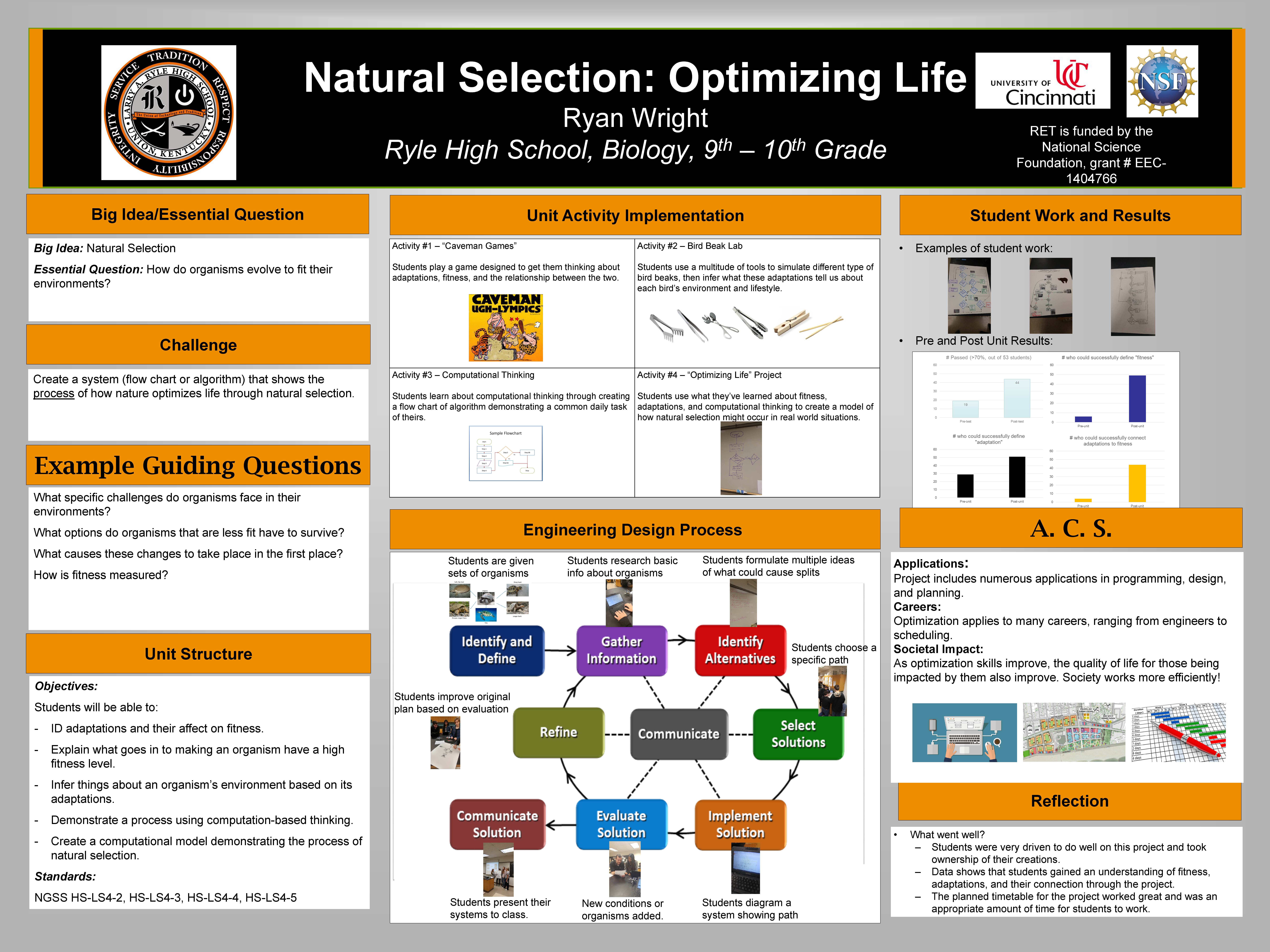Research Experience for Teachers (2017-2018)
Natural Selection – Nature’s Optimization Method
 |
||||||
|
||||||
Keywords:
|
|
The Big Idea (including global relevance) The big idea of this unit is Natural Selection. NS is the force that shapes all life on this planet – where we are going, and where we come from. As our environment changes over time, natural selection will decide which organisms survive and which will perish; with natural environments changing now more than ever, this is becoming even more important. |
|
Essential Questions
|
|
The Hook In the past, I have started my natural selection with a simple/fun activity I call the “Caveman Games”. This activity consists of several 10-12 small mini-activity that students compete in. Some of the activities are more athletic in nature, while others are centered around logical skills, or even artistic skills. Students are given a simple task (for example, “jump as high as you can and see if you can reach the banana hanging from the tree”). Students will either fail the event or succeed. They must then think about what traits they might have that helped make them more or less successful at this event. This gets students to start thinking about things like fitness and adaptations, as well as survival of the fittest (ie, natural selection), and it also reinforces that being fit is more than just being *physically* fit. This then leads into a discussion about what makes some lifeforms on Earth better at surviving than others, and about how these advantages come to be and/or are propagated. This is usually a pretty good hook in that it grabs students attentions from the get go – they love playing the games, and I usually dress up and do voices as we work through the “Caveman Games”. This gets them engaged and thinking about what I want them to think about. |
|
The Challenge Create a system (flow chart or algorithm) that shows the process of how nature optimizes life through natural selection. |
|
Guiding Questions
|
ACS (Real world applications; career connections; societal impact)
I feel like while this unit is a bit more on the abstract side, there are several real world connections to be made. Students are being asked to use real world programming skills, but they’re applying it to something that they probably wouldn’t normally apply it to. This activity will also easily tie in to global change and the way it stresses organisms, and will also connect to examples of natural selection that greatly influence student’s lives, such as the increase in antibiotic resistance in bacteria due to overuse.
I am going to make a real attempt to connect this to changes in biomes being caused by human impact and climate change, both of which have real societal implications.
Zoologists, biologist, and environmental activists would all be great speakers to bring in as a part of this unit.
Misconceptions
- Students have a tendency to think of evolution on a much smaller scale than it actually occurs; in other words, they think it occurs at an individual level as opposed to a population level, and think that it takes place within 1-2 generations as opposed to several.
- We will also need to dress the fact that many scientists believe that due to advances in technology and health care, humans are not really affected by natural selection anymore. Even less fit individuals are typically able to survive with proper care.
- Students often think that the evolution of a new species results in the replacement of the original. The flow charts they make will help them visualize how this is not the case, but be sure to stress that the loops on these charts represents different species “going their own way”.
Unit Lessons and Activities
- Lesson 1: Fitness and Adaptations
this lesson focuses on teaching the concepts of fitness, adaptations, and natural selection, and emphasizes the connection between the 3. Students work on 2 main activities designed to show them the effects that adaptations have on fitness, then work to unravel how nature may have shaped them to be the way that they are.- Activity 1 (Day 1): “Caveman Games” activity
- Activity 1 (Day 2): Introduce Big Idea, formulate Essential Questions, and come up with Challenge Ideas
- Activity 2 (Day 3): Bird Beak Lab, Day 1
- Activity 2 (Day 4): Bird Beak Lab, Day 2
- Lesson 2: Optimization Systems
this lesson focuses on the process of optimization and connects it to natural selection. Students learn how computers and businesses analyze a problem through computational/logical thinking, and attempt to connect that to what happens for life, first through their own expriences and then through what happens in the wild.- Activity 3 (Day 5): Present challenge, formulate guiding questions, begin flow chart activity
- Activity 3 (Day 6): Finish flow chart activity, share with clas
- AActivity 4 (Day 7): Go over challenge instructions, receive group and organism assignments, go over one example (Darwin’s Finches) as a class to demonstrate what students will be doing.
- Activity 4 (Day 8): Research organisms, complete table, formulate potential if/then statements for separating organisms.
- Activity 4 (Day 9): Choose if/then statements from yesterday and begin creating rough draft
- Activity 4 (Day 10): Finish draft, check-in with teacher, receive unknown condition and evaluate system’s ability to handle it. Refine and improve system to do so.
- Activity 4 (Day 11): Create final poster, finish PowerPoint
- Activity 4 (Day 12): Present poster and PowerPoint to class.
- Evidence of CBL: Day 2, Day 5, Days 7-12
- Evidence of EDP: Days 7-12
Additional Resources
